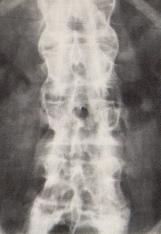This is a group of disorders with following characteristics, ( remember that spondyloarthropathies are popular questions in MRCP.
1) they are seronegative ( Rheumatoid factor negative)
2) usually larger joints are involved such as knees, ankles and sacro-iliac joints
3) if peripheral joints are involved, they are usually asymmetrical
4) characteristic articular features include enthesitis ( inflammation at sites of tendon insertion),dactylitis and scaroilitis.
5) strong association with HLA-B27
The arthropathies that are under this group are,
1) Ankylosing spondylitis
2) Reiter’s syndrome
3) Psoriatic arthropathy
4) Inflammatory Bowel athropathy ( Enteropathic arthritis)
Today I am going to talk about Ankylosing Spondylitis, it is a common short case as well if you are sitting for MRCP PACES, find more discussion at PassPACES.com
Clinical Presentations
Back pain and stiffness, usually happens during the third decade
Peripheral joint pain ( less common )
Uveitis
Physical Signs
Reduced spine movement and chest expansion
‘Question mark’ posture
Anterior uveitis
Anemia of chronic disease
Aortic regurgitation murmur
Achilles tendinitis
Apical fibrosis
Investigations
Sacro-iliac joints involvement

Spine xray- loss of lumbar lordosis, Bamboo spine ( calcification in anterior and posterior spinal ligaments)
Enthesitis
HLA-B27 positive ( about 90%)
Treatment
NSAID, NSAID, NSAID + physiotherapy
Disease modifying drugs have no effect on central disease ( spine) and maybe useful in peripheral disease ( peripheral joints involvement!)
Tips for MRCP,
1) They may show a spine x-ray or pelvic xray with classical history of ankylosing spondylitis, remember how to look for Bamboo spine and sacro-iliac joint involvement!

No comments:
Post a Comment